2012 Honda Civic Reviews
You'll find all our 2012 Honda Civic reviews right here. 2012 Honda Civic prices range from for the Civic to for the Civic Hybrid.
Our reviews offer detailed analysis of the 's features, design, practicality, fuel consumption, engine and transmission, safety, ownership and what it's like to drive.
The most recent reviews sit up the top of the page, but if you're looking for an older model year or shopping for a used car, scroll down to find Honda dating back as far as 1973.
Or, if you just want to read the latest news about the Honda Civic, you'll find it all here.

Bowser wowsers
Read the article
By Neil Dowling · 02 Aug 2012
Fuel prices have edged higher in the past week and that's the direction they'll keep going for now.This week the Australian Institute of Petroleum fuel price report shows the national average for unleaded petrol rose by 1.5 cents a litre in the past week to 137.7 cents.The metropolitan average rose by 1.8 cents to 136.3 cents, while the regional average rose by 0.9 cents to 140.5 cents.CommSec chief economist Craig James says: "The bottom line is that motorists should expect petrol prices to edge their way higher if the positive mood on financial markets continues.Filling up the car with petrol is the single biggest weekly purchase for most households, so the future course of petrol prices will be keenly watched by any consumer-dependent business."But surely not so closely as they're being watched by you. With that in mind, we've found the cars that on current prices can be fuelled for about $1000 in a 15,000km driving year.These cars get Carsguide's Triple-F rating - they are all family and fuel friendly. We've used the manufacturers' claims for combined conditions, so if you're driving is mainly urban you'll go north of these numbers; if there's a good open road component it will be south.We've taken broad averages to arrive at our round figures (see below) but they are indicative of what you can achieve with judicious driving and making your visits to the bowser on the days of the lowest pricing.ANNUAL JUICE USE TAKES INTO ACCOUNT:National average price in the 12 months up to Friday July 27 according to Australian Institute of Petroleum15,000km annual averageManufacturer's claim for combined fuel useULP: 134.7 centsDiesel: 137.9 centsFAMILY SEDANToyota Camry HybridPrice: from $34,990Thirst: 5.2L/100km unleadedAnnual juice use: $1068.60If Toyota is synonymous with sci-fi looking hybrids, its best one is cloaked in anonymity. Indeed it doesn't get much more anonymous than a Camry, the Hybrid version of which looks exactly like the common or garden petrol version.It shares the good bits - seven airbags, five-star crash rating and a full-size spare wheel - but its economy is staggering: 5.2L/100km versus 7.8L/100km for the petrol Camry. It's also quieter. In addition to using one-third less fuel, it costs $130 for each of the five services for the first four years or 75,000km.The price premium - $1,500 more than an equivalent petrol-only model - might pay off but the Hybrid model can tow only 300kg and the boot is slightly smaller. The top version, with near-Lexus levels of luxury, costs $41,490.FAMILY WAGONHyundai i40 Tourer dieselPrice: From $34,490Thirst: 4.7L/100km dieselAnnual juice use: $1,001.10In contrast with the gormless i45, Hyundai has done a great deal of local adaptation work on the i40 sedan. Even if the wagon does not yet have its specially-adapted-for-Oz suspension settings, it is a much better proposition than the i45.That miraculous fuel figure is for the manual, the action of which is a bit like stirring a stick though thick mud. Yet while the auto is claimed to use almost a litre more per 100km, on open road run between Sydney and Brisbane Carsguide recorded only 4.4L/100km.In any case, the sheer driveability of a diesel combined with a good auto makes it preferable. In solely city duty, the i40 is more likely to use above 8.0L, which is surely still worth it given the diesel's open road flair.SMALL SEDANHonda Civic HybridPrice: $35,990Thirst: 4.4L/100km unleadedAnnual juice use: $937.20Honda does a couple of obvious hybrids and one that's far less so. And the Civic version is arguably the best of its breed. The new Civic is a big jump from its distinctly average predecessor. It is up on quality and is simply far better to drive.It uses two power sources - petrol engine and electric motor - but unlike the Camry (and Prius) which can separate the two when needed, in the Civic Hybrid they work in tandem.This is technically simpler but returns higher fuel figures. The Civic Hybrid gets 4.4L/100km against the Prius's 3.9. Still, it's more spacious than the old model and needs smaller batteries so the boot is bigger.The rear seats don't fold down to increase luggage space. It gets a five-star crash rating, electronic stability and traction control, brake assist and six airbags, but a space-saver spare.SMALL HATCHVolkswagen Golf BluemotionPrice: $28,990Thirst: 3.8L/100km dieselUnlinkAnnual juice use: $809.40Golf can be played in a range of colours but the most efficient is blue. In VW-speak, it's BlueMotion, the in-house term for those selected models tuned for maximum economy and minimum emissions.The Golf BlueMotion costs $28,990 $1000 more than the Golf 77TDI that it replaced but comes only with a manual gearbox. But you're prepared the shift for yourself in order to save the planet, aren't you?A plethora of fuel-miser tech here low-rolling resistance tyres, stop-start system, brake energy recuperation, slippery aerodynamics, tall gear ratios and a gearshift prompt indicator are added to the already frugal 1.6-litre turbo-diesel. It's also a brisk performer with Golf's usual excellent handling and ride comfort. It works as well in city traffic as it does loping along a country road.COMPACT SUVMazda CX-5 Maxx Sport dieselPrice: from $39,040Thirst: 5.7L/100km dieselAnnual juice use: $1,214.10This slips us well over the grand mark, but torque isn't always cheap especially not 420Nm of it. CX-5s are selling like cold beers at the cricket because they are at least in diesel form very lively, economical and practical wagons.There's no doubt the CX-5's success is due to it enlarging in the appeal of the Mazda3 hatchback. But it's a better vehicle thanks to the SkyActiv tech that covers body, engine, transmission, suspension and platform. The bi-turbo four-cylinder diesel engine has class leading economy via its six-speed auto, despite the added weight of all-wheel-drive. Compact enough for comfort in city traffic, it's also very roomy with excellent rear seat leg and head space. The cabin could be a bit more stylish, but it’s simple and the controls are easy to operate. The rear seats split and fold flat. On the road the diesel version slaughters the petrol model.CITY CARFord Fiesta TDCiPrice: from $21,490Thirst: 4.4L/100km dieselAnnual juice use: $937.10In any guise the Fiesta is well made, affordable and a driver's delight. As a diesel it's also lean running. Made in Thailand, it's big on value. The 88kW/200Nm make this lightweight city car something of a hot hatch, with steering and handling to match.As with other diesels originally derived from Europe, you have to change gear for yourself, though with the arrival of the next EcoBoost petrol engines next year, Ford's excellent twin clutch automatic could become available. Sedan and hatch are identically priced.Though the five door brings the extra load flexibility of its ilk, the sedan's boot approaches that of the next class up in terms of capacity. It'll swallow a monthly grocery shop all right. The diesel is specially calibrated for maximum fuel efficiency and features a coated particulate filter to keep emissions low. The Zetec spec, at $23,490, is worth the extra spend.
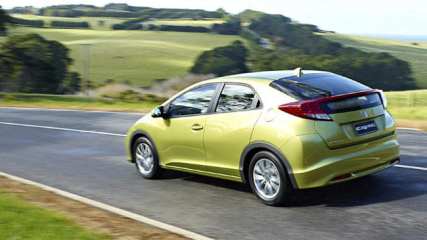
Honda Civic hatch 2012 review
Read the article
By Ewan Kennedy · 03 Jul 2012
A truly global vehicle, the new Honda Civic is manufactured in Britain and was developed with extensive testing throughout Europe.Civic VTi-S is available with either a six-speed manual or five-speed automatic transmission, while the VTi-L is auto only.Prices start at a very reasonable $22,650 for the VTi-S manual and peak at $29,950 for the VTi-L. On-road costs have to be factored in.To start the ball rolling on sales of the new model Honda is offering the VTi-S at drive-away prices of $24,990 and $27,290 respectively. They are on sale now.Honda is placing much store on its new Civic Hatch and predicts sales of both models will be split down the middle 50:50. The company says it is also looking forward to adding a further buyer inducement with the stable being joined by a 1.6-litre diesel version next year.The standard audio has USB connectivity, iPod integration, auxiliary jack and speed-sensitive volume control. Bluetooth, fitted on VTi-L only, can be had on VTi-S at extra cost. The VT-L carries a premium sound system with seven speakers including tweeters and sub-woofer. Hill start assist is standard across the range. Cruise control with variable speed limiter is available on VTi-L only.The new Hatch comes in two models – the VTi-S and VTi-L – both powered by an upgraded 1.8-litre four-cylinder i-VTEC engine producing 104 kW of power at 6500 rpm and 174 Nm of torque at 4300 rpm.Civic VTi-S is available with either a six-speed manual or five-speed automatic transmission, while the VTi-L is auto only. Prices start at a very reasonable $22,650 for the VTi-S manual and peak at $29,950 for the VTi-L. On-road costs have to be factored in.Improved aerodynamics, together with Honda’s fuel efficient technology, have the new Civic Hatch coming up with consumption figures of 6.1 litres per 100 kilometres for the manual transmission and 6.5 L/100 km for the automatic on the Australian combined driving cycle. Carbon dioxide emissions are put at 146 g per kilometre (manual) and 155 g / km (automatic) on 95 RON petrol. Emissions standard is Euro IV.Fuel efficient technology featured on the Civic hatch is called ECO Assist using the car’s speedometer illumination – blue (bad) or green (good) – to tell drivers how their driving is affecting fuel economy.A green dash-mounted Econ switch activates the most economical and environmentally friendly settings for the car by selecting the best throttle position for accelerator pedal pressure to smoothly increase torque. Eco Assist also improves the efficiency of the air-conditioning system, again saving fuel.Honda research found drivers liked the styling of the previous model, with its futuristic looks and practicality but baulked at the car’s limited rear vision and felt that the rear design could look more sophisticated.The car’s spacious and user-friendly cockpit design was well liked, with the clever ‘magic seat’ system in the rear offering added cargo room receiving much positive comment. Users, however, were not too happy with the quality of materials used.As a result of this feedback, the new Civic Hatch has a sporty sleek exterior with a cabin cleverly packaged to offer versatile occupant and cargo space together with comfortable and stress-free driving conditions.The designers took their lead from the ‘blended body’ aircraft in which fuselage and wings fuse into a single unit for superior aerodynamic performance and quietness.The result is a lower and wider Civic Hatch front and profile, with smooth surfaces combining with the sculpted wheel arches and concealed rear door handles, tailgate treatment and flat underbody to produce improved aerodynamics (Cd 0.30).A new functional cockpit layout includes a full-colour Intelligent Multi-Information Display screen incorporating the Eco driving facility, audio display and other information.Soft-touch surface materials are used throughout for an improved quality feel, a new tilt and telescopic steering wheel has easy-to-operate controls, while the VTi-L wheel is finished in extra-smooth leather with more comfortable stitching.A low extra rear window gives a better view from the driver’s seat and there’s improved crosswind stability.The new Civic hatch has already gained a five-star ANCAP safety rating. LED day-time running lights (switched off when headlights are on) and LED brake/tail lights ensure the vehicle is highly visible to other road users at all times.On a run organised by Honda through Sydney’s southern suburbs and on a mix of country and highway driving the new Civic Hatch performed up to Honda expectations.The six-speed manual shifted gears with little effort, making for comfortable and relaxed going. Steering was direct and well weighted, offering good road feedback, while the ride was supple yet responsive to changing driving conditions.There was no getting away from differences in performance in Econ mode with the need to change down a gear or two more often to cope with inclines or overtaking. The automatic transmission was sufficiently sorted to take similar conditions in its stride.
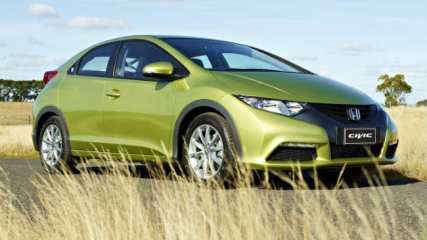
Honda Civic 2012 review
Read the article
By Vlad Manu · 27 Jun 2012
Britannia is still ruling the wave of Honda Civic hatches. While the Honda Civic sedan we get here comes from Thailand, the hatches arriving in showrooms this week are being shipped from Britain.Honda says Australia is a unique market in getting product from both factory streams. And the flagging carmaker is determined to make the ninth-gen Civic hatch a success in the increasingly competitive C segment – and get back closer to their former glory days of strong sales. So the hatch has been given an exterior makeover, revised engine and fuel efficiency tricks from the CR-Z hybrid, along with a sharper starting price.The revised 1.8-litre 4 cylinder engine produces 104kW/174Nm and boasts fuel consumption of 6.1 litres per 100km six-speed manual and 6.5 litres per 100km in the five-speed auto – an improvement of about 10 per cent, but it does require a diet of 95 octane fuel. However eco modes are there to try and encourage you to drive more efficiently. The manual comes with a shift indicator light while the automatic gets paddle shifters behind the steering wheel.Research into noise has resulted in a much quieter cabin -- for a car in this price range we were surprised at 110km/h to be able to hear approaching cars.Priced from $22,650 for the VTi-S (manual), the entry point is significantly less than the Civic Si hatch model it replaces. It’s just over $7,000 cheaper than the starting price of the old model and compared with the 2009 price of the Civic Si a whopping saving of over $17,000. There's now a choice of six-speed manual or five-speed auto transmissions ($24,950) in the VTi-S trim, and the top of the range VTi-L only comes as an auto ($29,990).The features list includes 16-in alloys, hill-hold assist, LED daytime running lights, climate control, intelligent multi information display and a four speaker audio system with AUX and USB input. Bluetooth is a dealer fitted option of the VTi-S and disappointingly there’s no cruise control offered on this model. Most competitors have this option covered as standard.The automatic only VTi-L gains extras like 17-in alloys, auto headlights and wipers, fog lights, electric side folding mirrors, dual zone climate control, reversing camera, leather trim, seven speaker audio system as well as Bluetooth connectivity and cruise control. Satellite navigation and sunroof are notably missing even from the extra options list. Leather heated seats in the VTi-L are inviting and obviously more comfortable than the standard fabric seats in the VTi-S.Exterior changes are minimal at first glance. The LED daytime running lights give the car a sportier look, and aerodynamics have been improved, but the problem is that the car looks very similar to its predecessor. The new hatch won’t be seen as revolutionary as when the Si Civic was first unveiled.The redesigned dash layout is uncluttered and easy to read, is arguably now the benchmark in this segment. It’s a smart looking interior all around with good quality plastics used throughout.There’s a lot of room in both the front and rear, and Honda also retained their ‘magic seat’ configuration that can flatten the back seats to create a huge cargo area, or fold them to make more room for tall items.It gets a five star ANCAP safety rating, and has six airbags, stability control, anti-skid brakes and a good helping of other active and passive features.The focus is clearly on saving fuel and for most situations in urban driving this is more useful than brisk performance. So the engine performance is capable rather than startling.The manual gearbox was smooth but the auto box with steering wheel mounted paddle shift was not as responsive as we’d like when left in auto mode. For extra overtaking oomph the ability to quickly drop down a couple of gear ratios without your hands leaving the steering wheel worked well.The Civic’s smooth suspension system is quiet, and handled bumps quite well during our drive. It was surprisingly well composed during our run through the Royal National Park near Sydney. Steering felt light, responsive and direct thanks to the electric powered rack and pinion system. The car’s agility and stability through corners was better than expected.
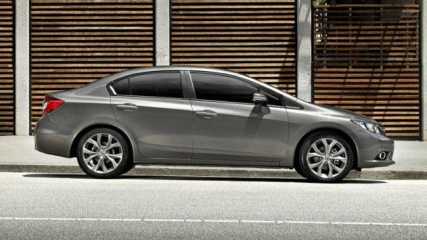
Honda Civic VTi-L sedan 2012 review
Read the article
By Mark Hinchliffe · 14 Jun 2012
Over the past few years Honda has lost its mojo. It axed sporty cars such as the Integra in 2006 and the S2000 in 2009, it quit Formula One in 2008 and when the GFC hit it canned the next NSX supercar and sat on its hands while other car companies forged ahead with research and development.Honda has been left with a range of boring city cars and people movers with no more soul than a Camry hire car. But things are changing with the announcement of a return of the NSX, a spunky new British-made Civic hatch arriving in our showrooms now and rumours of a Type-R version down the track.However, in its 40th year in Australia, the rather boring Civic sedan remains the Japanese manufacturer's top-selling vehicle.In the lead-up to the launch of the attractively priced Civic hatch, Honda dropped its prices on the Thai-made sedan by several hundred dollars.Honda Australia director Stephen Collins says the Civic hatch and sedan prices are the result of the strong Australian dollar and "an aggressive pricing strategy" and follows massive price reductions of up to $4300 on the Accord.It comes in three variants - VTi-L, Sport and Hybrid. Build quality is excellent which is reflected in strong resale values, however servicing intervals are frequent and spare parts prices are high.The VTi-L we drove features the 1.8-litre VTEC naturally aspirated engine, with better fuel economy thanks to the ECO Assist button which reduces air conditioning drain, changes the characteristics of the throttle and displays how economically you are driving.But the fuel-saving auto stop-start function available in Euro models is not be coming to Australia to keep prices down. The engine has just 1kW more of power and the same amount of torque.Technology inside is presented on two information screens and there is USB and iPod connectivity plus Bluetooth audio streaming in the VTi-L which works well.While the hatch is a sexy swimsuit model, the sedan is the dowdy cousin operating the lights for the catwalk. The "boomerang" shape of headlights and grille is a nice touch but the rest of the car is rather plain.Inside Honda has tried a little too hard to look futuristic with its split-screen instruments. Unfortunately, when the steering wheel is in the right position for me, I can't see the speedo properly.The cabin has a feeling of quality without being luxurious, but the cloth seat trim is very "hire car".All Civics, except the four-star Hybrid, get a full complement of five ANCAP safety stars. Safety equipment includes six airbags, including full-length curtain airbags, stability control and rear parking sensors. Under the cargo floor is a temporary spare.Comparing the Civic sedan to a Toyota Camry is not completely fair. The latest Camry is a vastly better car while the Civic has made only marginal improvements.However, the two can be compared favourably in cabin noise. Both are eerily quiet and represent industry benchmarks. This makes for a relaxed and unhurried drive experience. Just as well because the engine isn't exactly fiery. Like most Honda engines it likes lots of revs and that's not possible with the automatic.With the ECO Assist button deployed it's quite asthmatic. Even with the button switched off it struggles on hills thanks to low levels of torque. Steering is light enough for traffic duties yet stable on the highway, however it has a disengaged feeling. The pedals feel a bit mushy and soft, also with limited feel.Suspension is compliant for a plush ride that doesn't give a lot of feedback when the car is pushed a little hard. Accommodation is comfortable all round for five adults and the seats are soft, but supportive, and adequate for long-haul duties.
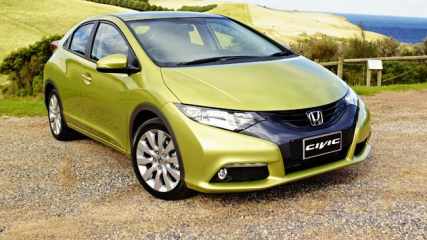
Honda Civic VTi-L 2012 Review
Read the article
By Chris Riley · 25 May 2012
Inoffensive. In a word. The Civic used to be such a fun, sporty little car but who's hiding it and when can we get it back?Honda is doing a great job out of Toyotaring Toyota, with a car that does everything extremely well but is almost totally devoid of character. This one on the other hand feels like it is targeted at retirees (not a bad thing considering this is a growing market).PRICE AND EQUIPMENTPrices for the VTi-L start at $20,990 plus on road costs. The auto adds $2300 bringing the total to $23,290. But the Sport at $27,990 is another $4700 but includes the auto. The extra dosh buys you a sunroof, leather upholstery, fog lights and 17 inch alloys. Standard features in both models include Bluetooth and iPod connectivity.TECHNOLOGYEven though the VTi-L has a smaller engine than the Sport, it goes nearly as well and is not disappointing. The VTi-L model’s 1.8-litre SOHC four-cylinder petrol engine with 16 valves and a dual-stage intake manifold is a refined version of the previous engine.The engine produces almost identical figures to last year's model at 104kW of power and 174Nm of torque. It's hooked up to either a five-speed manual or five-speed adaptive auto with steering wheel mounted paddle shifts. The Sport in comparison produces 114kW/190Nm seems hardly worth the effort.The new engine has extensive changes that reduce friction, improve emissions and increase fuel economy. The changes have reduced fuel consumption from 7.2 litres/100km to 6.7 litres. During our test program the car returned a figure of 7.4 litres/100km which shows it is more than achievable. CO2 emissions are slightly down too at 158g/km (previously 164g).SAFETYGets a full five stars for safety. A long list of standard safety equipment including front, side and curtain airbags, anti-lock brakes and next-generation Vehicle Stability Assist (VSA).DRIVINGThe VTI-L is a big vehicle for a small car with plenty of room for mature adults. It’s easy to get in and out of and easy to drive and park. The Motion-Adaptive Electric Power Steering (EPS) improves steering response at low speeds. I like the big centrally located digital speedometer which makes it easy to tell exactly how fast you're going at a glance. But I don't like the space saver spare, even though there's room for one in the biggish boot.The VTI-L is extremely smooth and quiet inside and zips through traffic with consummate ease. It lacks the low down torque of the Sport with its larger 2.0-litre engine but there is very little difference in the way they drive once it's up and running. With the ECON economy option activated, throttle response is more gradual, shift pattern is reconfigured in the auto and climate control operation is altered. It certainly saves fuel but throttle response is sluggish.VERDICTAfter driving the two Civic sedans back to back I've come to the same conclusion as last time. And that is, forget the Sport, save your money and stick with this the entry level VTi-L model.2012 Honda Civic VTI-LPrice: from $20,990Warranty: Three years/100,000 kmEngine: 1.8-litre, 4-cyl petrol, 104kW/174NmTransmission: 5-speed manual, front-wheel driveBody: 4540mm (L); 1755mm (W), 1435mm (H)Weight: 1180kgThirst: 6.8 L/100km, 161 g/km CO2
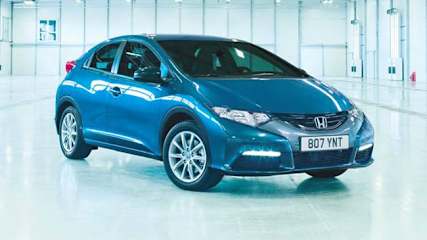
Honda Civic hatch 2012 review: road test
Read the article
By Ewan Kennedy · 11 May 2012
Honda’s Civic sedan and hatchback are two quite different machines. While other companies come up with cars that are identical except for their rear end treatment, Honda chooses to build two quite different models to significantly broaden buyer choice. Civic four-door sedan has been on sale in Australia for several months. It’s aimed at relatively conservative buyers and is built in either Thailand or Japan.While the Civic hatch is very much a European machine, it has a dynamic look and feel and is bought by the young and the young at heart. Interestingly the Honda Civic hatch is totally built in a factory in the UK.If you thought the previous Honda Civic hatch had striking good looks just wait until you see the new one. The first batch is already on board a ship on its way down under and will go on sale late in June.We have just spent three solid days in the UK and Germany, watching the Civics being built and driving them on the autobahns of Germany as well as on some stunning scenic backroads of that beautiful country. More about our driving impressions in a moment.Though there are obvious similarities in the front end styling of the new Civic hatch, everybody panel is different to that on the sedan. The rear has a stunning new shape. In particular the rear lights act as an integrated spoiler with their sculpted shape designed to smooth the air as it leaves the back of the car. Thus achieving a class leading Cd figure of just 0.27 - something that seemed all but impossible until now.Honda Civic is one of the best looking five-door hatches of all. Yes, it does have five doors, just check out the concealed handles and view the way it seems to have the sleek lines of a two-door hatch / coupe.As well as the rear light / spoiler, other aerodynamic aids are in the shaping of the front end, the semi-blister rear guards and out of sight panels beneath the car that make air pass cleanly under it. This aero shape has been achieved without any loss of headroom under that sleek rear roofline.Inside, the Civic hatch has a similar layout to the sedan we reported on the other day. This includes the clever double-level instrument panel, with the digital speedometer sitting high for virtually instrument readout.Working in conjunction with the body shaper are changes to the 1.8-litre petrol engine, the manual and automatic transmissions and suspension changes combine to give the new Civic an official fuel consumption figure of just 6.1 litres per hundred kilometres.Yet Honda has given us a strong hint that even better engines are on their way. Apparently the current unit, while significantly better than the 1.8 it replaces, is in its final stages of revisions and will be replaced by an all-new power plant within about two years.In an interesting move, the European arm of Honda has suggested the Australian importer also takes delivery of turbo-diesel engines. So Australian buyers will have the option of a super-economy 1.6-litre Civic diesel midway through 2013.Unfortunately the diesel is only mated to a six-speed manual gearbox at this stage as that’s the way European drivers prefer them. Honda Australia has teamed with some other markets to try and push Honda into designing an automatic transmission to sit beside the turbo-diesel engine.New Civic hatch has a many primary safety aids, including intelligent ABS brakes and vehicle stability control systems. Sadly, active cruise control and crash mitigation systems that are offered on topline versions of Civic have been discounted for our market due to relatively high costs.Systems like these are only seen on ultra-expensive European cars in Australia at this stage so we understand Honda Australia’s point of view. But, who knows, if enough Australian buyers indicate a willingness to pay for these items they may yet eventuate. Perhaps make a call to your local Honda dealer…In the meantime, six airbags will do all they can to protect your body and those of other occupants should things still go badly wrong.We saw the 205km/h on our speedo during our German motorway drive and there was more in hand. (Curiously, we didn’t die, so it appears the laws of physics in Germany must be different to those in Australia where our governments tell us 111 km/h could claim our lives at any moment…)Civic hatch is smooth and quiet to ride in thanks to having an even stiffer body than before. Part of the refined feel is due to the use of fluid-filled suspension bushes at the rear, another feature that’s normally only found in expensive European saloons.Engine performance is good without being outstanding as there is now a leaning in the direction of economy and low carbon emissions in the performance / consumption compromise. Torque is strong and the six-speed manual has neatly chosen ration and is positive in its actions. Steering leans in the direction of sportiness with a good feel through the steering wheel.As it’s still several weeks before the new Honda Civic hatchback arrives in Australia the company won’t reveal its pricing strategy at this stage - other than to say the price list will begin in the mid-twenties. The fact that the new model should rightly be regarded as European is likely to assure buyer acceptance at that price point.
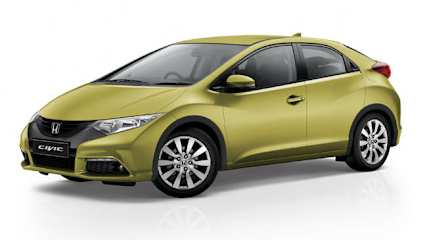
Honda Civic manual hatch 2012 review
Read the article
By Mark Hinchliffe · 11 May 2012
Sex usually sells, but not in the case of the British-made Honda Civic hatch. The sexiest of the small-car hatches is expected to only account for one in three Civic sales, compared with the more sedate-looking and slightly less practical and less flexible sedan made in Thailand. Honda Australia director Stephen Collins says the Civic hatch has previously been priced as a more niche product. He says the lower price will give this model more mass-market appeal, but still not as high as the sedan.He expects to sell about 400 hatches a month while the sedan, launched in February, will sell about 1000 a month. Surprisingly the Poms have got it right with only their locally made hatch being available in Britain. Collins says there are no plans yet for the even sexier Type R hatch, but if there are, Australia would take it.Buyers can expect a saving of as much as $5000 when the ninth-generation Honda Civic hatch arrives in Australia in June. Collins says it will start at "the mid-$20,000s" compared with the previous five-door Si hatch which sold out at prices starting from $29,990. He says this is the result of the strong Australian dollar and "an aggressive pricing strategy" and follows recent price reductions of up to $4300 on the Accord. We can only imagine how cheap the hatch would be if it was built in Thailand like the sedan, rather than Swindon, west of London.It will arrive in two trim levels - VTi and VTi-L - with six-speed manual available in the base model with hill-start assist and a five-speed also available in the VTi-L. Unfortunately, VTi doesn't come with cruise control which is standard in most of its competitor because Honda Australia wanted to "keep the price competitive", says Collins. The VTi-L adds leather seats,rain-sensing wipers, dual zone air con, front fog lights, 17-inch wheels, rear camera, leather seats, cruise control and a premium audio system with subwoofer in the boot. A locally developed satnav will be available as an accessory.There has been little change here. It features the same 1.8-litre VTEC naturally aspirated engine, with slight tweaks that give it just 1kW more of power and the same amount of torque. The improvement in fuel economy of 0.8L/100km in the manual and 0.7L/100km in the auto is a substantial 10 per cent gain, due mainly to aerodynamics in the body and underbody. Honda Europe spokesman Christoph Rust says "two or three" former F1 engineers were involved in the aerodynamic design. It also has an ECO Assist button which reduces air conditioning drain, changes the characteristics of the throttle and displays how economically you are driving. But the fuel-saving auto stop-start function available in Euro models will not be coming to Australia in a further effort to keep a lid on prices. Instead, a 1.6-litre diesel engine with manual transmission will be available in the first half of next year, says Collins. Technology inside is presented on two information screens and there is USB and iPod connectivity plus Bluetooth audio streaming in the VTi-L.This is the Miranda Kerr of the small hatch world - petite, pretty from every angle and just enough curves to be sexy as hell. Unlike Kerr, the Civic hatch sits lower and wider than before. The most polarizing feature of the design is its tasty rump with the new combination lamp design and brake-light cluster.It retains the hidden rear door handle now adopted in the stunning Hyundai Veloster. The cabin has a familiar Honda feel which is not luxurious, but certainly a quality build. It now adds soft-touch trim and extra-smooth leather with more comfortable stitching in the VTi-L. Hatch comes in seven colours – Yellow Topaz, Alabaster Silver, Crystal Black, Deep Sapphire Blue, Milano Red, Polished Metal and White Orchid - with a black interior. The VTi has cloth trim while the VTi-L gets leather trim and heated front seats. Honda’s flexible rear folding seats add practicality to the interior layout.Collins says it will receive a five-star Australian safety rating based on European results. The Civic hatch has the same level of safety equipment as the sedan with six airbags, including full-length curtain airbags. It also has a strong body, stability control, tyre deflation warning system and a reversing camera for the VTi-L. That camera should be standard in both trims as the rear hatch creates a huge blind spot. Rust says the rear window has been increased to reduce the blind spot, but it still presents a large blind spot for following traffic which can't be fixed by a reversing camera. Also, the rear wiper only sweeps the top half of the split window. Under the massive, flat cargo floor is a temporary spare.At 206km/h on the autobahn between Nuremberg and Munich, the Honda is fizzing at over 6000 revs in sixth gear but still not king of the road. Here it's at its upper limits and having to get out of the way of rapidly encroaching Vorsprung Durch types. But these are unfamiliar and irrelevant conditions for Australia where it will run in the 100km/h highway traffic with ease. The suspension is tweaked a little tighter than in the sedan, but it's still a compliant ride, although it is difficult to determine just how plush it will feel on our lumps and bumps. Rust says the rear suspension bushes are filled with fluid for a smooth ride over corrugations.We drive only the six-speed manual over almost 1000km in Germany, mainly on autobahns, and find the ratios well suited to grand touring. But with Australia's limited speed zones, sixth and even fifth cogs may be a little too high for regular use. Honda's rev-happy engine is better when worked around 4500rpm in gears one through to four. The pedals and the gearshift feel a little mushy and light, but some drivers prefer that feel. We would prefer a more positive and direct sensation. Steering is tighter, but the ratios are the same, resulting in a confident and stable feel even at 200km/h-plus. Cabin noise is low, even at high speed. It only becomes a concern on some coarse tarmac and over abrupt changes of surface such as cobblestones. We found the driving position ok, but the steering wheel reach adjustment too short and the seats way too hard with a protruding and non-adjustable lumbar support. Our backsides were crying for relief after an hour in the saddle. For those who like the steering wheel positioned high, it also gets in the way of the speedo.
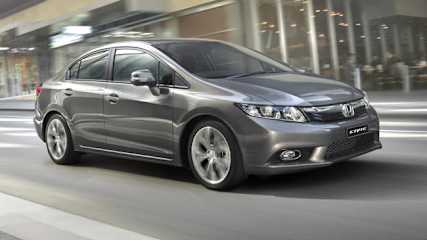
Honda Civic Sport automatic 2012 review
Read the article
By Ewan Kennedy · 04 May 2012
The all-new Honda Civic is larger than ever, to the extent that it can be used as a family car by those downsizing from a traditional six-cylinder Ford, Holden or Toyota.Civic is all about style these days and the new model has that ‘sculpted from a single billet’ look that’s a strong evolution of the now superseded car. A strong seller in Australia, indeed worldwide, for many years, the Civic is sold in a big variety of models here and there are even more in the offing.Now in its ninth generation, the Civic is being sold in three versions Civic VTi-L and Civic Sport and, the most interesting one, the Civic Hybrid. Interior space in the Civic hatchback is fine for four adults, with space in the centre-rear for another without too much discomfort. Despite the slim and sleek appearance headroom is fine.We liked the complex double-decker styling of the dash and instrument area, with the digital speedo sitting high to make it easy to keep track of. Good quality plastics are used on the trim, but we were a little disappointed in the somewhat mundane grey-on-grey colour scheme. Boot space is good and the luggage is reasonably easy to load through an opening that’s wide and practical.There’s a big emphasis on in-car entertainment and communication in the latest Civic. A screen in the right-centre of the dash displays the functions of the phone, iPod and audio systems. These are controlled by buttons on the steering wheel to minimise driver distraction. Two conventional petrol engines are being offered, something that’s not common in this class, where ‘sports’ generally means some extra badges and larger wheels.The Civic VTi-L is powered by a 1.8-litre, 104 kW engine, the Sport’s powerplant has a capacity of 2.0 litres and produces up to 114 kW of power and 190 Nm of torque. Honda Civic VTi-L has a choice between a five-speed manual or six-speed automatic transmission. Oddly, the Sport only comes with the automatic.Arguably the most caring of all car companies about the environment, Honda is continuing its work on petrol-electric hybrids. Major changes have been made to the electric motor and it is now powered by a lithium-ion battery in place of the nickel-metal-hydride of the previous model. This gives it more grunt off the line and, while not turning it into a sports machine in its acceleration, it has plenty of performance for day-to-day driving.Our test review of the new-gen Civics was done chiefly on the Sport, though we did spend a little time in the Hybrid as well. We will get back to the latter in weeks to come. Only the four-door Civic sedan is coming to Australia at this stage, it’s imported from the recently reopened Honda factory in Thailand. As before, the five-door Honda Civic hatch will be built in Honda’s plant in the United Kingdom.We have been invited to tour that factory in a couple of week’s time, followed by a substantial test drive of the cars. Thus we will be able to report on them two to three months before they arrive downunder. Ride comfort is good as Honda has increased suspension travel and worked on recalibrating bushing compliance so they are more suited to rough and ready Australian country roads.The 2.0-litre engine in the Civic Sport is very Honda in the way it loves to rev. While there’s reasonable torque in the low and midrange, it’s when you get the engine towards the top end of the tacho that it really starts to sing. Keen drivers will love it and learn to make the automatic transmission work in the areas they like best.Fuel consumption during our test period was in the eight to ten litres per hundred kilometres range around town, falling to sevens in the country. Handling in the Civic Sport is quite sharp and it turns in neatly and positively, with good feedback through the steering wheel.
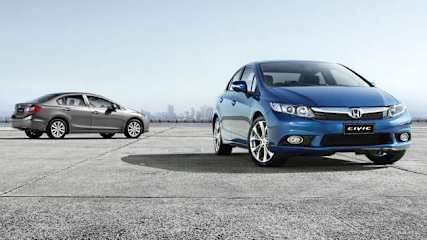
Honda Civic Sport 2012 review
Read the article
By Chris Riley · 01 May 2012
Believe it or not this year marks the 40th anniversary of the Honda Civic. More than 20 million Civics have been sold world-wide since production began in Japan back in 1972.Over 200,000 of those cars have found homes in Australia where it sought after by young drivers, with its reputation for being sporty, reliable and economical. A couple of years ago the Civic actually morphed into two cars but both kept the same name: a European designed and built hatch and Japanese produced sedan (although the sedan actually comes out of Thailand).Our test car, the Civic Sport sedan, which was released earlier this year, is now in its ninth generation.The Civic has evolved into a large small car over the years, with comfortable accommodation for four adults, along with a good-sized boot (seats up to five). At a pinch it's big enough to use as the family car but you could run out room when the holidays roll around. It's easy to get in and out of and easy to drive and park, with a 50-litre fuel tank that takes standard unleaded fuel.At $27,990 it's a whopping $7000 more than the standard VTi-L. The badge suggests something far more exciting than the standard fare, but if it's there we missed it.For starters the fact you can't get a manual is going to rule it out for many, especially the "doof-doof" boys. Bluetooth with audio streaming and steering wheel phone and audio controls are standard, with AUX and USB ports. For the extra dosh the Sport gets the auto ($2300 option otherwise), leather, fog lights, 17 inch alloys and a sunroof but that's the extent of it.The Sport gets a 2.0-litre engine instead of a 1.8, with an output pf 114 instead of 104kW and 190 instead of 174Nm of torque. Both are single cam jobs but the jump in power is really not that great and not much of a drawcard (surely it's the primary reason for buying a sporty model?).You can get the VTi-L as a manual or automatic, but the Sport comes only with the five-speed auto albeit with paddle shifts. The car goes well enough and dropping the transmission into sport mode elicits a more aggressive response, but you won't want to leave it there for long because the engine races and is unable to settle.It lacks low down torque and in typical Honda fashion doesn't really get going until you have around 4500 revs on the dial where its more responsive. There's plenty of grip and it sits nice and flat on the road with a low centre of gravity that gives the car a real "planted" feel.Fuel consumption is rated at 7.5 litres/100km (we were getting 8.5) and the car has a full 5-star safety rating with all the latest safety gear.We like the big digital speedo. The dash is divided into upper and lower tiers, with controls grouped according to function. Despite the leather upholstery it still has that overly plastic insubstantial feel that many Hondas seem to have.It sits on 17 inch alloys with a temporary spare. The rear looks like a lift from the Benz C-Class. There's no sign of satnav, no climate air, no power seat adjustment, no lumbar adjustment for driver's seat, no cool LEDs, no rear spoiler, no body kit and certainly no dual exhaust outlets.
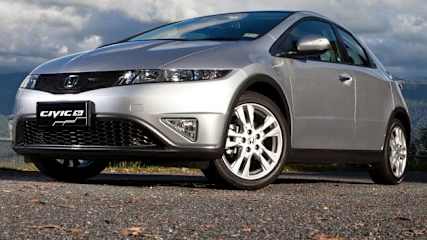
Honda Civic Hatch 2012 Review
Read the article
By Mark Hinchliffe · 25 Mar 2012
Imagine Jon Bon Jovi in comfy trousers crooning with a cocktail bar ensemble. That's the Honda Civic Si Hatch. It's built in Britain alongside the Type R which wears tight leather pants and screams punk rock. The Si is a toned down and mellowed-out version with softer suspension and more sedate performance.VALUEWhile most of our Honda product hails from Thailand, this Civic hatch comes from Britain, so it has some nice styling touches that make it stand out from the Thai-built sedans. However, at $29,990, it's more than $5000 above the corresponding Civic sedan and several thousand more than comparative Japanese and Korean five-door hatches. It aligns more closely in price with Euro-made hatches such as the Ford Focus, Peugeot 308 and Renault Megane. Value is aided by features such as climate control airconditioning, Bluetooth, rain-sensing wipers, fog lights and rear parking sensors, plus Honda's traditionally good resale value, reliability and build quality.TECHNOLOGYHonda was the first to use variable valve technology in its engines which converts it from a mellow kitten at low revs to a screaming wildcat at high revs. While this 1.8-litre engine is hardly a wildcat, it does work much better at high revs. The i-VTEC 4-cylinder engine is mated to a five-speed auto or six-speed manual gearbox which earn their keep by maintaining optimum revs to get the most out of the 103kW peak power and 174Nm torque. The Si hatch now comes with Bluetooth which is quick and easy to connect and reliably pairs every time, even with my iPhone 4 which can be difficult to pair with many car Bluetooth systems. Unfortunately the Bluetooth connection doesn't include music streaming, but there are AUX/USB connectors and a convenient 12V outlet in the centre console.DESIGNI owned a 1979 Honda Accord hatch which seemed smaller than this Civic. Apart from growing in size, the Civic hatch has also leapt ahead with modern styling inside and out. The design also has a racing influence with a mesh grille replacing the clear plastic grille, a race-style petrol cap, integrated tailpipes like the Type R and Flash Gordon door handles including hidden door handles on the rear door. On the tailgate there is a stylish spoiler in the middle of the glass. Inside, there are drilled pedals, sporty steering wheel, a big red start button like S2000 and a futuristic dashboard with controls that are easy to understand. SAFETY There are six airbags, ABS, electronic brake-force distribution, electronic stability and a tyre-pressure warning system earning it five stars in Euro NCAP crash tests. However, it fails on the visibility stakes with the stylish rear spoiler splitting the rear window and creating a blind spot.The rear three-quarter view is also limited by a thick C pillar and the driver's door mirror doesn't fold out far enough to view the next lane, although there is a convex end to the mirror which I find confusing because it is distorted. Although it comes with rain-sensing wipers, there is no wiper on the rear and the top half definitely needs it as water pools there. A roof-mounted wiper would fix that. DRIVINGIt might look like a Type R, but this is a sheep in wolf's clothing. You have to vigorously stir the gearbox to get good motivation and the shifter feels notchy and frail. At least the clutch is also light so it's good for city driving with lots of cog-swapping. Handling is capable and consistent, never messy or fussy. Just point and go. There is a lot to like about this Civic. It feels classy inside, if a little noisy on the highway. Honda has also given quite a bit of thought to the package with some useful touches such as the 12V outlet in the cargo area, wide-opening rear doors and clever, flat-folding 60-40 split rear seats. There is plenty of room in the back for three adults and the centre rear seat has a lap-sash belt, but there is a bump in the seat which makes it uncomfortable. Niggles include the driver's door mirror, temporary spare and tailgate vision. But the biggest bugbear is the futuristic split instrument panel with the all-important speedo at the top obscured by the top of the steering wheel. Not everyone will experience this, but I like the steering wheel high and close and in that position I simply couldn't see how fast I was driving. VERDICT Like Jon Bon Jovi, the Honda Civic Si should appeal to those who like their adult-oriented rock in a more palatable form. It looks like a Type R, but it's actually a hatch for everyday use.Honda Civic Si HatchPrice: $29,990 ($32,290 auto)Warranty: 3 year/100,000km; 6 year rustService: 10,000kmResale: 53% after 3 yearsEngine: 1.8-litre i-VTEC, 4-cylinder, 103kW/174NmTransmission: 6-speed manual (5-speed auto), front-wheel driveEconomy: 6.9L/100km (7.2 auto)CO2: 163g/km (172 auto)Dimensions: 4270mm (L), 1765mm (W), 1460mm (H),Kerb weight: 1285kg, (1320kg auto)Tyres: 225/45 R17, temporary spare




